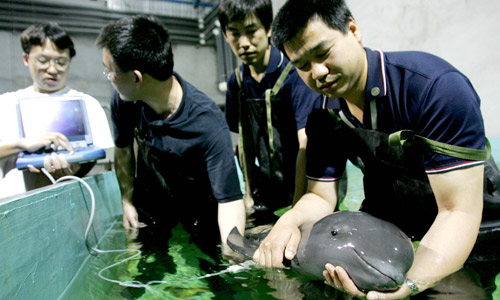|
 |
|
RECEIVING TREATMENT: A young injured finless porpoise is treated by doctors at the Beijing Aquarium on May 8, 2008 (LU XIN) |
In 2002, the world's first artificially fed white-fin dolphin passed away at the age of 23.
Mankind missed the best time to save the white-fin dolphin, but a similar tragedy should not be allowed to happen to the finless porpoise, Wang said.
Good news came in 2008. After three years of preparation, a Yangtze freshwater cetacean conservation network was eventually set up, funded and supported by IHB, World Wildlife Fund and fishery management departments at all levels in China. It means more systematic conservation work for the Yangtze cetacea would be carried out. At that time, six cetacea conservation areas and two observation stations for the finless porpoise joined the network.
The last shelter
The Tianezhou Nature Reserve in Shishou, Hubei Province, was selected as a shelter for the white-fin dolphin, the finless porpoise and other endangered aquatic animals in 1990. The water in the reserve has no pollution at all. Currently, dozens of finless porpoise that have been bred from the initial five, are living there.
The porpoise live in floating cages, a method of breeding called "soft release" by scientists. In this way, the porpoise can live in fresh water all the time and at the same time it is convenient for scientists to observe the porpoise and collect data about the creature, including feeding, health and reproduction. Scientists identify the porpoise's problems and take appropriate action in time.
The reserve is considered the world's first successful example of cetacean conservation. Besides the Tianezhou Nature Reserve, nearly 10 nature reserves for the finless porpoise conservation have been set up in the middle and lower reaches of the Yangtze River since the 1990s, covering a total area of 4,202 square km. But the system differs from the protection of land-bound species such as giant pandas, because river shipping can not be blocked and pollution damage to the reserve areas can not be prevented. Scientists are full of confidence that one day they would send these porpoise to their real homes.
Now, many wild finless porpoise are being squeezed out to the Boyang Lake, Jiangxi Province, making China's largest freshwater lake another major shelter for the porpoise.
From 2005, IHB researchers made a two-year study on the finless porpoise in the lake. They found there were around 100 porpoise appearing in the lake throughout the year.
From the outlet of the Boyang Lake to the Laoyemiao area is the habitat for the densest cluster of porpoise feeding and breeding. The number of porpoise living there is approximately 450, the largest population of wild Yangtze finless porpoise, around one third of the total.
In March 2010, researchers launched a survey of the porpoise population in the lake following the last survey in February 2009. Researchers made a comprehensive physical examination of captured porpoise and also fitted them with the Passive Integrated Transponder tags to monitor the living condition of the creature. | 